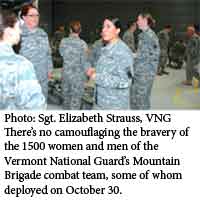Vermont Youth Orchestra – Symphony of Youthful Spirit & Sophisticated Passion
When she was just two years of age, Olivia Daniel of Starksboro spotted a group of violinists playing on Burlington’s Church Street. Peering up at her mother she demanded, as only a child can, “When am I going to get my violin?”
Olivia – now a high school senior and musician in the Vermont Youth Orchestra (VYO) – remembers being determined. “Of course my mother thought I would let it go, but six months later I was still bugging her about it so she finally let me take lessons,” Olivia says with a smile. She’s been playing the violin ever since, and ten of those years have been spent immersed in music education through the programs of the Vermont Youth Orchestra Association (VYOA).
As have most of her VYO colleagues, Olivia has ascended upward through the octaves, if you will, in a series of VYOA educational and performance opportunities.
Read the full article |
 |
| |
|
Home Front: Vermonters Gear Up for the Mountains of Afghanistan
The rumors were confirmed when the order came in July 2009: 1,500 Vermont Army National Guard members will be deployed to Afghanistan in early 2010. That means one in every 400 Vermonters is headed out for a mission of 12 to 14 months. It’s the largest Vermont National Guard deployment since World War II.
The 1,500 are members of the 86th Infantry Brigade Combat Team (Mountain), a light-infantry brigade and the only mountain brigade in the entire National Guard. As participants in the tenth installment of Coalition Joint Task Force Phoenix, the Guard members will be part of a team of 10,000 soldiers, contractors, and translators training Afghan military and police officers. The Vermont contingent is under the command of 29-year-old Colonel Will Roy, who has done three tours in Afghanistan.
Read the full article |
 |
| |
|
An Agent for Change – Susan Hammond and the War Legacies Project
For many, the Vietnam War is now relegated to history textbooks. While Americans might be aware of how it affected U.S. veterans, less is known here of its impact on the Vietnamese people. And we’re rarely reminded that the latter still suffer from one aspect of the war in particular: the use of Agent Orange.
Between 1961 and 1971, the U.S. sprayed 21 million gallons of Agent Orange over southern Viet Nam, as well as Laos and Cambodia, to defoliate dense forests and improve visibility for planes. The toxic herbicide contained TCDD, the most dangerous form of dioxin, which is itself “among the most toxic anthropogenic substances ever identified,” according to a 2006 report by the National Academy of Sciences. The side effects of exposure include increased rates of premature births, spontaneous abortions, stillbirths, a range of birth defects, and uterine cancer.
According to the War Legacies Project (WLP) – a non-profit now based in the southeastern Vermont town of Bartonsville – approximately three million Vietnamese currently suffer from Agent Orange-related illnesses or disabilities, including 150,000 children affected by their parents’ exposure.
WLP Director Sue Hammond has made it her life’s work to raise public awareness of the lingering effects of Agent Orange on the Vietnamese people, as well as increase direct aid to them.
Read the full article |
 |
| |
|
Linda Perham – Those for Whom She Advocates are Legion
“Does anybody see anything wrong with this picture?” asked Linda Perham, holding up an article about the American Legion’s leadership to her colleagues in the organization’s national membership committee. The question elicited only puzzled stares, so Perham answered it for them with a playful rebuke: “You’re all too old, you’re all too white, and you’re all too male!” Perham is recounting this anecdote as we sit in her Westminster kitchen on a gloriously warm Vermont autumn afternoon. As she continues her story, it’s hard to miss her enthusiasm for the 90-plus-year-old veterans advocacy institution – and her belief that it can play a meaningful role in the lives of 21st century veterans and their communities.
“We want to represent – and the American Legion should represent – veterans,” Perham says she told the group. “There’s no Hispanics, there’s no blacks, there’s no women, and our statistics have shown that these are the people who do not join and stay in the American Legion.” Illustrating the alienation these constituencies might feel, she invoked another scenario: “If you’re the only Protestant in the Catholic mass, you feel uncomfortable – so eventually you just leave.” Perham summarizes her colleagues’ reactions with an impish grin. “Some agreed with me, while others said, ‘Well, I’ve been on this committee for 80 years…’”
To which she adds earnestly, “I just feel like we should look like the people we’re representing.”
I haven’t seen Perham in over 25 years since she graduated from the high school we both attended, Bellows Falls Union. The lanky basketball-playing senior I knew then (as Linda McLean) later enlisted in the Army, and was stationed at various locations out of state and overseas before returning to Vermont and earning her nursing degree.
Read the full article |
 |
| |
|
Novel Gift Choices That Won’t Be Returned to Sender
Fiction lovers planning on gifting copies of Lorrie Moore’s or Hilary Mantel’s latest for the holidays would do well to look closer to home: Vermont boasts a slew of talented women novelists. Here are five new works of fiction that appeared in 2009, all by experienced authors. Delve into the world of dairy farming or small-town Vermont life; plow through a suspense novel or linger over a family saga. There’s something for everyone.
Eugenie Doyle’s excellent young-adult novel, According to Kit, is set on a Vermont dairy farm and vividly invokes the feel of working one. Doyle and her husband have run The Last Resort Farm in Monkton since 1985. (Of the tongue-in-cheek name, she says wryly, “It was definitely not a resort, but it was the destination we wanted to arrive at.”) The farmer and mother of three became a writer only after they sold the cows – they now produce organic berries and vegetables – but dairy farms are the setting for both her debut YA novel, the critically acclaimed Stray Voltage, and her latest.
According to Kit takes place over the winter of Katherine Snow’s fifteenth year, when a classroom knifing episode prompts her mother to pull her for homeschooling. An aspiring ballet dancer who helps her parents with farm chores, Kit thinks her mother is being overprotective but acquiesces because of the extra dance classes she’s offered in return. The problem is that Ursula, her beloved dance teacher at the local college, is battling multiple sclerosis and looking for a substitute. And it’s soon apparent that her mother, who seems to use chores as a defense against sadness, is too busy for homeschooling, leaving Kit to essentially self-educate.
Read the full article |
 |
| |
|
Asthma – Statistics That May Take Your Breath Away
As autumn winds down and winter approaches, many people welcome the relief from allergies the season brings. But even the cold and snow don't lessen breathing problems for a significant portion of the population -- asthmatics.
Asthma is a chronic inflammation of the lungs characterized by narrowed airways. During an asthma attack, a person experiences a potentially dangerous shortness of breath. About seven percent of the world population is affected by the disease, which is responsible for approximately 4,000 deaths a year in the U.S. According to asthma data reported by the Vermont Department of Health in 2007, nearly 10 percent of Vermonters have asthma.
“There are things that families and individuals can do to keep people with asthma healthy, like using pillow and mattress covers to control for dust mites, keeping pets outside of the bedroom, and other housecleaning measures,” says Sheri Lynn, a representative from the Vermont Department of Health.
Avoiding allergens such as pollen, dust, and animal dander is critical in managing asthma and minimizing attacks. It's also important to minimize exposure to environmental pollutants, something that's not as easily controlled.
The four major air pollutants regulated by the U.S. Environmental Protection Agency that have been highlighted as contributing and exacerbating factors to asthma are: smog, particulate matter, sulfur dioxide, and nitrogen oxide. According to the Natural Resources Defense Council, multiple studies have shown that hospitalizations for asthma increase on days when high levels of particulate matter and other ambient air pollutants are recorded for the area. Second-hand tobacco smoke is also is considered a significant factor in causing asthma. Formally known as environmental tobacco smoke, it affects millions.
Read the full article |
 |
 |
Grateful Thread… Short-Lived
“What would Margaret Michniewicz be like if she lived in the 1800s?” This was the burning question posted on my social networking page recently – and admittedly, the answers from my friends were amusing, ranging from one who had me frolicking in the Scottish countryside as part of a band of traveling musicians, to another who was confident I’d be an abolitionist with secret compartments in her home. But as I briefly envisioned myself in these activities with bemusement, I paused and thought, “Seriously, what would I be doing if I lived during the nineteenth century – or, more to the point: what would be available to me, as a woman, to do and be?”
Suffice it to say, I’m relieved that my time on earth is now, not then. The contrast of options that have been available to me, but not my mom, is stark enough. As we kick off the holiday season with Thanksgiving, I gratefully acknowledge the opportunities I have as editor of this publication to bring our readers stories of women living here in Vermont – and the fascinating and important work they do. Those included in this issue are no exception.
Read the full article |
|
|